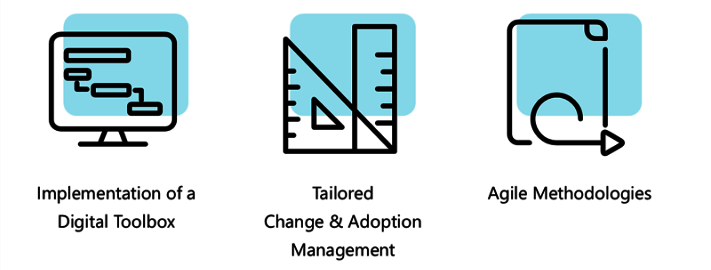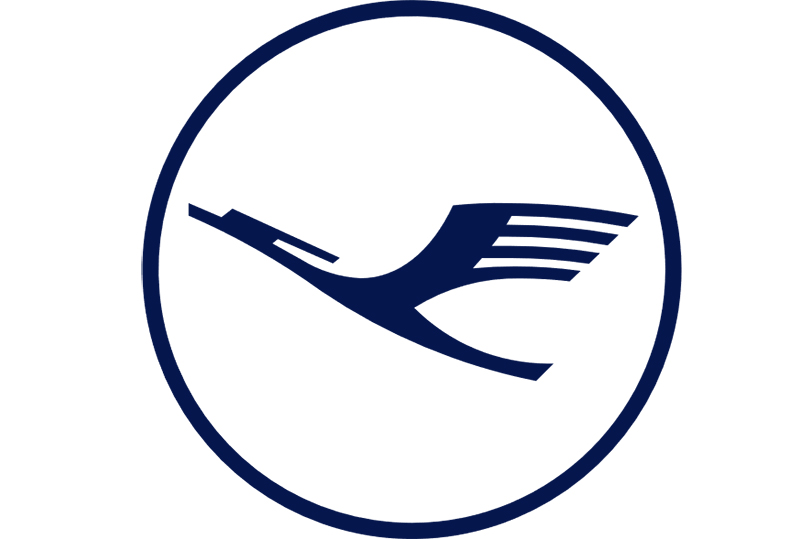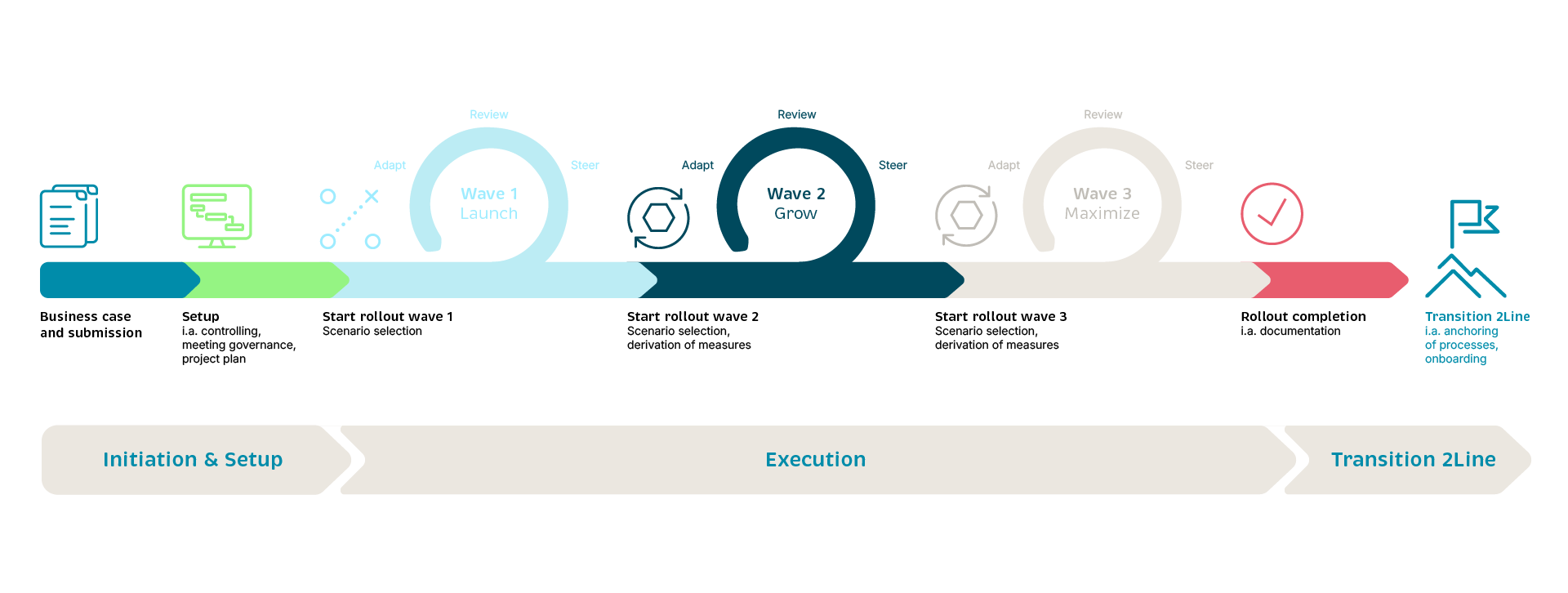
- Industry: Aviation
- Number of employees: 102,000
- Headquarters: Frankfurt am Main
- Website

As one of the largest airlines globally, Lufthansa Airlines (LHA) continuously works on its market positioning. In this context, it aims to further expand its fleet. It is crucial for the aviation company to meet internal and external quality requirements, especially regarding the safety-relevant Technical Fleet Management (TFM). The focus is particularly on further digitizing the associated processes.
TFM is responsible for technical operations (TechOps), including the maintenance, repair, and airworthiness of the aircraft. The "Digital Technical Fleet Management" department launched the "Digital Push" initiative, aiming to increase efficiency and upgrade the hardware infrastructure to state-of-the-art technologies.
One of the measures identified by TFM was the introduction of a Digital Toolbox: a digital, personalized device, specifically a tablet computer, for productive employees in aircraft maintenance. This was intended to enable live use of the Maintenance Information System employed by LHA while working on the aircraft. Synergies were to be achieved through the simultaneous introduction of a mobile version of the Maintenance Information System.
The goal was to equip and familiarize more than 1,300 employees at the Frankfurt and Munich locations with the new devices within a few weeks. Additionally, employees needed to be prepared for the change and ensure a high usage rate of the devices.
LHA decided to commission Campana & Schott, a partner with whom several digitization initiatives had already been successfully implemented. Together with CS, TFM realized a smooth and rapid introduction of the Digital Toolbox. CS relied on a proven methodological approach based on experiences from numerous rollout projects. In this context, the CS team brought not only its project management but also its change management expertise.
Shortly after project completion, the first visible benefits emerged: the efficiency of the entire team and, consequently, the quality of work results and employee satisfaction were increased.
Success Factors – Needs-Based Project Processes
For the successful rollout of the Digital Toolbox, Campana & Schott relied on various expertise and experiences. The key success factors were:
- Cross-functional Collaboration
Close collaboration with departments and other project teams led to great acceptance and support for the project. Decisions could be quickly made and represented together. For example, the rollout planning took into account the specifics of shift operations in coordination with the managers. - Transparency through Clear Reporting & Controlling
The establishment of appropriate structures and processes, as well as the implementation of controlling tools, ensured the necessary transparency at all times. Risks and opportunities could be regularly reviewed, and decision needs quickly derived. - Agile Working Methods
The targeted use of agile working methods put customer benefits at the forefront. Iterative rollout planning enabled quick reactions to adjustment needs. After each completed rollout wave, the approach was evaluated and adjusted as needed. - Lean Project Governance
The establishment of an efficient control and communication structure, as well as clear responsibilities, were critical to success. The project team could make relevant decisions at any time in coordination with the department management, significantly accelerating project progress. - Focus on User Acceptance and Satisfaction
During the physical distribution of the toolbox, feedback was continuously collected to implement improvements immediately within each rollout wave. - Change Management
Continuous communication measures to the workforce, training materials, and documentation supported the successful change and fostered a positive attitude towards the change.
Methodical Approach – From Initiation to Rollout
For the Digital Toolbox project, the CS team chose a rollout approach tailored to the framework conditions. It consists of the project phases Initiation & Setup, Execution, and Transition 2Line. The iterative approach within the Execution phase offered the opportunity for continuous adjustments and optimizations during the project.
Initiation & Setup
The analysis of central challenges in hardware and software areas was followed by the creation of the business case and the submission of the Digital Toolbox.
After successful project approval, it was necessary to quickly establish a needs-based project setup. This included the establishment of project controlling, the definition of meeting governance, and the development of project planning in MS Project in collaboration with all stakeholders.
Key milestones included the setup of distribution processes at the Frankfurt and Munich locations, the configuration of 1,300 digital devices, and the establishment of interim service and asset management.
Execution
After the project was set up, CS managed the Execution phase and accompanied the toolbox rollout iteratively in three waves. CS ensured the achievement of goals throughout the rollout: the team steered (steer) each wave, conducted retrospectives (review) of the approach and measures taken, and implemented measures for each wave (adapt).
Wave 1: Launch
The first wave focused on efficiently distributing the maximum number of Digital Toolboxes to the "first movers," who showed high motivation to use the DTB. The goal was to quickly increase acceptance and visibility of the toolbox. Improvement potentials were identified and measures immediately derived, such as device setup or specific maintenance software. In the launch wave, mechanics were given the opportunity to book appointments and pick up the Digital Toolbox through a booking tool, considering the existing three-shift operation to reach all employees.
Wave 2: Grow
The second wave aimed to use the insights from the first wave to ensure high efficiency in the rollout. Therefore, the distribution was flexibilized, allowing the toolbox rollout without appointment booking. This optimally responded to the limited availability of mechanics.
Wave 3: Maximize
In the third and final wave, the goal was to fully distribute the devices to the mechanics. To achieve this, the insights from the first two waves were analyzed, and various distribution scenarios were derived. Organizational units with low distribution rates in the first two waves were reached through the responsible group leaders. The toolboxes were handed over directly to the managers at an agreed time, who coordinated further distribution to the respective mechanics. For departments with high distribution rates, the distribution was coordinated directly with the employees by the project team. The distribution was managed in close collaboration with the managers of the involved organizational units.
Transition 2Line
With the rollout of the last devices to the mechanics, the implementation phase was successfully completed. Subsequently, Campana & Schott created the final and process documentation for future regular processes.
The Transition2Line phase focused on streamlining and implementing support and distribution processes in regular operations. Additionally, onboarding for employees from relevant departments in the line organization for future regular processes was conducted. The project team ensured that the processes, especially in support, were anchored in the organization. The focus was on interim processes for hardware-related issues, such as distribution to new employees or return from departing employees, as well as other application and software-related issues. The interim processes were valid until a specific date, after which a permanently responsible service point was to be established.
To accompany the change in the organization, CS relied on targeted change and communication measures.
Result – Rollout within just Three Months
Within just three months, over 1,300 devices were successfully rolled out. Already 57 working days after project approval, the first devices were handed over to the mechanics. The establishment of (interim) support processes and the definition of processes were implemented. With the rollout of the Digital Toolbox, the Digital Technical Fleet Management succeeded in creating the foundation for implementing further digitization ideas and a future-proof platform for innovations.


